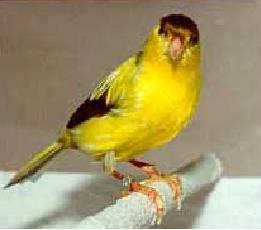Canary - German Roller
Roller Canary, Hartz Mountain Roller Canary Scientific Name: Serinus canaria
Mon, 14th July, 2025 - 8:14 pm GMT
Sponsor Ads:

Alternative Name
Roller Canary, Hartz Mountain Roller Canary Scientific Name: Serinus canariaBasic Info
Most German Roller Canaries are between four and a half and five inches in length. They are not bred for their size, color, or feathering; rather, they are bred for their songs! This means that Roller Canaries can vary greatly in appearance. Breeders are constantly experimenting with new types. Most, however, have a rather flattened head and straight back. The defining characteristic of the German Roller Canary is its song, which is produced with the beak closed. This gives it a lower timbre and less shrill sound than the songs of many birds. It is the lower tone of the German Canary's song that makes it so pleasing to the human ear. German Roller Canaries do have the ability to produce high-pitched tones.
Health
German Roller Canaries who are kept about 72 degrees Fahrenheit constantly will go into soft molts. The best time to purchase a Roller Canary is November, as by this time the birds will have finished their summer molts and you will have a good idea of the bird's appearance. As with other canaries, they are generally not compatible with other birds - they are territorial and usually will require their own cages. Breeding German Roller Canaries usually breed in late March. In order to breed your Roller Canaries, place a pair in a cage, which allows room for a nest. The birds will also need nesting material. The hen bird will aimlessly carry nesting material about for a while, depositing it messily. When she becomes neater and more efficient in nest building activity, she is ready to mate and the male will court her. Hartz Roller Canaries usually lay four or five eggs at one or two day intervals. These eggs have brown speckling over a bluish green base color. They will incubate for 13 or 14 days and during this time, the parent canaries should be fed eggfood. Young Hartz Roller Canaries will be fed by their parents for about a month. By three weeks of age, they will begin to move about the cage and eat seeds and eggfood in small amounts. Generally Roller Canaries are not weaned fully until about four weeks of age, though they fledge at about two weeks of age they cannot crack seed very well until they are about a month old. As soon as the Roller Canaries are weaned they should be placed in separate cages.Habitat
N/ABehavior
Reputed to have the most pleasing song of all canaries, the German Roller Canary sings with its beak closed! These charming little birds have been prized for centuries for their sweet singing. Highly prized by many, German Roller Canaries are skilled not only in singing but also mimicry! When keeping such a bird, you should be sure that it is not too hot and not too cold! Place its enclosure in a place that is free of drafts. Although seasonal variation is acceptable, try not to keep your bird at a height above eye level, since heat rises. The best temperature range for a German Roller Canary is 50 to 70 degrees Fahrenheit. Although they need lots of natural daylight, it is essential that your German Roller Canary be allowed ten to 12 hours of dark time, or sleeping time, in a quiet setting. German Roller Canaries will do well in a cage of about two feet by 15 inches by 15 inches in dimension. The cage bottom should be covered in sand and the birds should have a cuttlebone available on which to dull their beaks. German Roller Canaries will need clean, fresh water available to them at all times and they may be fed a standard diet of canary seed mix. This should be supplemented daily with fresh green food, bits of fruit like apple or orange, or even corn on the cob. Male German Roller Canaries tend to sing much more nicely than female canaries. Males can be territorial, however, and should not be kept together in the same cage. When showing German Roller Canaries, they are usually shown in "teams" of four birds, which enhances the full experience of their songs! With proper care German Roller Canaries should live at least 10 years.Origin
Canary IslandsHistory
Sometimes known as Hartz Mountain Roller Canaries, these birds were extensively bred in the Tyrol region of Germany. It should be noted that in North America the 'Hartz' canary is a distinct and separate breed from the 'German Roller'. It is not even a song breed - it is classed as s 'Type' canary, and has not been bred for song for at least a century. The old European name for the German Roller was the 'Hartz Mountain Roller', and for this reason some people still get these terms confused with the present day breeds. German Roller Canaries originate from the Canary Islands, from whence Spanish monks obtained breeding pairs. They sold the males and kept the females for breeding. These song canaries were so popular that they spread throughout Europe. In the 1800's, a breeding center became established in the Hartz Mountains and the Roller Canary became selected for its song. These canaries were classified into type by segments of their song. By 1922, a standard song evaluation rubric was developed, and songs were rated by their Hollow Roll, Flute, Bass and Hollow Bell sounds. The standard is still used today with a few minor adjustments in place. Today, German Roller Canaries remain very popular and are still bred for their lovely songs.Common Foods
N/ASponsor Ads:
Gumperson's Law: The probability of anything happening is inversely proportional to its desirability.
Canary - German Roller
Coded by: BGID® | ALL RIGHTS RESERVED Copyright © 2000-2025
Disclaimer | Privacy | Report Errors / Contact | Credits








 President of the United States of America - Real Estate mogul, Pageant owner and now one of the most controversial men in political history.
President of the United States of America - Real Estate mogul, Pageant owner and now one of the most controversial men in political history.  Global warming has been in and out as the "latest" hot topic for many years. It is, according to modern scientists, the result of man-made industrial pollutants, clearing forested areas, agriculture, etc. But now they are thinking it started way before the Industrial Revolution...
Global warming has been in and out as the "latest" hot topic for many years. It is, according to modern scientists, the result of man-made industrial pollutants, clearing forested areas, agriculture, etc. But now they are thinking it started way before the Industrial Revolution...  Politician, US Vice President and President of the USA - Joseph Robinette Biden Jr.
Politician, US Vice President and President of the USA - Joseph Robinette Biden Jr.  versus
versus  Russia: 'The Evil Empire'? Are they all that bad or is it just the USA trying to portray Russia as bad because they are a world power with land bigger and a society very different from the USA ideal?
Russia: 'The Evil Empire'? Are they all that bad or is it just the USA trying to portray Russia as bad because they are a world power with land bigger and a society very different from the USA ideal? 
 Corona virus
Corona virus 
 Users with wide screen monitors can benefit from more content on every page.
Users with wide screen monitors can benefit from more content on every page.